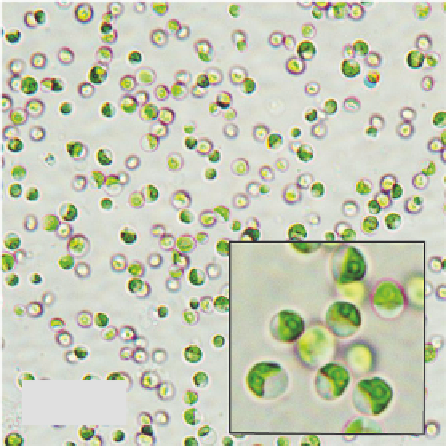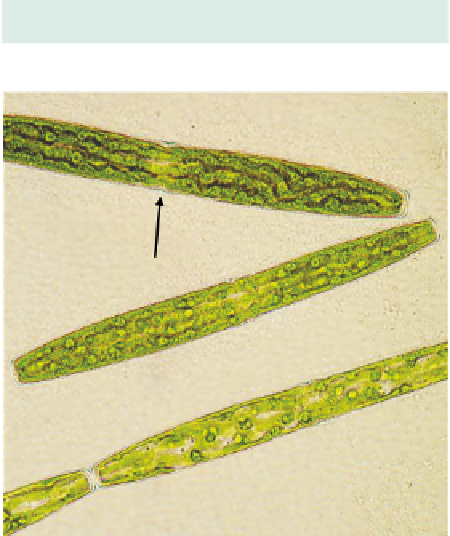Environmental Engineering Reference
In-Depth Information
with pyrenoids. Common, but rarely abun-
dant, in lowland waters. Chlorophyta.
Plate XXVIII.
(b) Cells not as above. Groove hardly or
not present. If present the slight groove is
equal in size on both sides of the cell or
not obvious. There may be a clear area
in the mid-region of the cell between two
chloroplasts........................
212
212
(211) (a) Cells with a cylindrical or near cylin-
drical shape . ......................
213
(b) Cells not cylindrical in shape. . . .
217
Desmids are almost entirely freshwater
with only a few occurring in brackish con-
ditions. Taxonomically they are divided
into two groups - (1) the Saccoderm
desmids, which have a relatively simple
shape lacking a median constriction and
(2) the Placoderm desmids that have a
median constriction, dividing the cell into
two semicells.
25 μm
Figure 4.74
Chlorella.
Main image: low power view
of algal culture. Inset: Cell detail, showing parietal
chloroplast and apical clear region.
Most desmids are single cells although a
few form filaments. Some aggregate in
masses, held together by a large quan-
tity of mucilage. The study of desmids
using a microscope has long been popu-
lar because of their beautiful shapes (e.g.
Micrasterias
and
Euastrum
.Notinkey,
see Plate XXIX, Fig. 4.81).
213
(212) (a) Cells are an elongated straight cylin-
der, sometimes slightly tapering at ends.
About ×10 as long as wide, with a shal-
low but noticeable constriction in the mid-
dle.....................
Pleurotaenium
100 μm
In
Pleurotaenium
,
the median constric-
tion is not deep and a swollen area may
be present on either side of it. Cells (20-
650 μm length, up to 75 μm wide) have
numerous long band-shaped chloroplasts
and pyrenoids. Often found in soft, more
acid, waters and amongst mosses. Chloro-
phyta. Plate XXVIII. Fig. 4.75.
Figure 4.75
Pleurotaenium.
These large algal cells
have a median constriction (arrow). Chloroplasts are
arranged in longitudinal bands (seen clearly in top cell)
and have numerous pyrenoids.





Search WWH ::

Custom Search